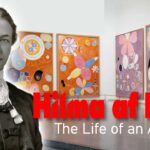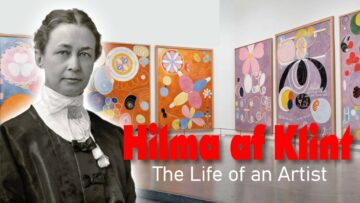

Like many artists whose abstractions cemented their legacy, Hilma af Klint was trained to paint portraits, botanicals, and landscapes.
The naturalist works of her early adulthood depict bourgeois, late-19th century Swedish life, and, by association, the sort of subject matter and approach that were deemed most fitting for a female artist, even in a society where women were allowed to work alongside men.
But something else was afoot with Hilma, as artist and educator Paul Priestley points out in the above episode from his Art History School series.
Her 10-year-old sister’s death from the flu may have caused her to lean into an existing interest in spiritualism, but as Iris Müller-Westermann, director of Moderna Museet Malmö told The Guardian’s Kate Kellaway, the “mathematical, scientific, musical, curious” teen was likely motivated by her own thirst for knowledge as by this family tragedy:
You have to understand this was the age when natural sciences went beyond the visible: Heinrich Hertz discovered electromagnetic waves [1886], Wilhelm Röntgen invented the x-ray [1895]…Hilma is like Leonardo – she wanted to understand who we are as human beings in the cosmos.
Her interest in the occult did not make her an outsider. Spiritualism was considered a respectable intellectual preoccupation. Abstract painters Vasily Kandinsky, Piet Mondrian, Kasimir Malevich and Frantisek Kupka were also using their art to try and get at that which the eye could not see.
All but Hilma were hailed as pioneers.
The New York Times review of Los Angeles County Museum of Art’s 1986 exhibit The Spiritual in Art: Abstract Painting 1890-1985, mentions some of their spiritual bona fides:
They were generated by such ventures into mysticism as Theosophy, Anthroposophy, Rosicrucianism, Eastern philosophy, and various Eastern and Western religions. Spiritual ideas were not peripheral to these artists’ lives, not something that happened to pop into their minds as they stood by their canvas. Kupka participated in seances and was a practicing medium. Kandinsky attended private fetes involved with magic, black masses and pagan rituals. Mondrian was a member of the Dutch Theosophical Society and lived briefly in the quarters of the French Theosophical Society in Paris. He said once that he ”got everything from the Secret Doctrine” of Theosophy, which was an attempt by its founder Helena Petrovna Blavatsky to do nothing less than read, digest and synthesize all religions. It has been known for some time how much of Mondrian’s symbolism – including the ubiquitous vertical and horizontal lines – and how much of his utopianism, was shaped by Theosophical doctrine.
Reviewer Michael Brenson devotes one sentence to Hilma, “a previously unknown Swedish artist whose somewhat mechanical abstract paintings and drawings of organic, geometrical forms were marked by Theosophy and Anthroposophy.”
Thirty-five years later, she’s receiving much more credit. As Priestley says in his video biography, Hilma, and not Kandinsky, is now hailed as the first painter to experiment with abstraction.
Would Hilma have welcomed such a distinction?
She maintained that she was but a receiving instrument for Amaliel, a “high master” from another dimension, who made contact during the séances she participated in regularly with four friends who met weekly to practice automatic drawing and writing.
Amaliel charged her with creating the artwork for the interior of a temple that was part of the high masters’ vision. The Guggenheim’s classroom materials for The Paintings for the Temple note that her friends warned Hilma against accepting this otherworldly commission, “that the intensity of this kind of spiritual engagement could drive her into madness.”
But Hilma threw herself into the assignment, producing 111 paintings during a one-and-a-half year period, claiming:
The pictures were painted directly through me, without any preliminary drawings and with great force. I had no idea what the paintings were supposed to depict; nevertheless, I worked swiftly and surely, without changing a single brushstroke.
For whatever reason, the paintings proved too much for Rudolph Steiner, the founder of the Anthroposophical Society, whom she had invited to view them, paying his travel expenses in hope that he would provide a detailed analysis and interpretation of the images. Instead, he counseled her that no one would understand them, and that the only course of action would be to keep the paintings out of sight and out of mind for fifty years. To do otherwise might endanger her health.
A disappointing response that ultimately led to the paintings being socked away for an even longer period.
Good news for Kandinsky… and possibly for Steiner.
At any rate, the competition was coerced into eliminating herself, inadvertently planting the seeds for some major, if delayed art world excitement. Hilma, who died more than forty years before the L.A. County Museum show, was not able to bask in the attention on any earthly plane.
For those curious in a take that is not entirely rooted in the art world, Lightforms Art Center in Hudson, New York hosted a recent Hilma Af Klint exhibit. Their strong ties to the Anthroposophical community make for some interesting exhibit commentary.
Related Content:
New Hilma af Klint Documentary Explores the Life & Art of the Trailblazing Abstract Artist
Discover Hilma af Klint: Pioneering Mystical Painter and Perhaps the First Abstract Artist
Ayun Halliday is an author, illustrator, theater maker and Chief Primatologist of the East Village Inky zine. Follow her @AyunHalliday.
The Life & Art of Hilma Af Klint: A Short Art History Lesson on the Pioneering Abstract Artist is a post from: Open Culture. Follow us on Facebook and Twitter, or get our Daily Email. And don't miss our big collections of Free Online Courses, Free Online Movies, Free eBooks, Free Audio Books, Free Foreign Language Lessons, and MOOCs.
from Open Culture https://ift.tt/3AOiLNH
via Ilumina

Comments
Post a Comment